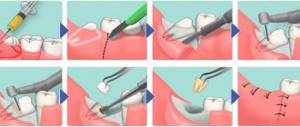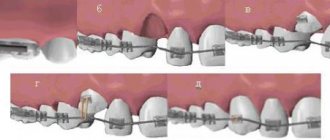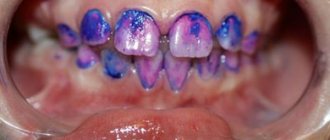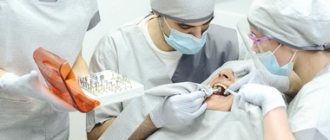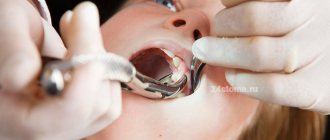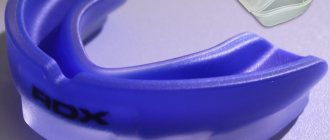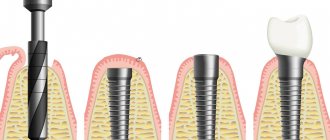Surgical dentistry is the branch of dentistry that is responsible for surgical operations in the mouth and jaw. Surgical dentistry also deals with the removal of teeth and tumors, implantation, as well as the treatment of jaw injuries.
When might dental surgery be needed? There is a common belief that dental surgery comes down solely to tooth extraction. However, this is not entirely true - the leading task of this area of dentistry is not the removal, but the preservation of teeth and oral health.
Like any surgical intervention, dental surgery is a last resort. They are used when conservative treatment is ineffective, for example, with pathological occlusion, complications of diseases, gum pathologies, etc. Thus, dental surgery offers a whole arsenal of tools for correcting mistakes made by man and nature itself.
Let's consider situations when it is appropriate to resort to dental surgery in more detail.
Tooth-preserving operations
These are operations aimed at the surgical treatment of diseases that threaten the integrity of the teeth.
The most common of these interventions are cystectomy and cystotomy. With the help of these surgical procedures, the cyst is treated without tooth extraction. Removing the contents of the cyst and carefully treating the affected cavity allows you to keep the tooth completely intact.
If the root is infected, the tooth can still be saved. To do this, resection of the root apex is performed - removal of the affected root fragment. If the root cannot be saved, it will be amputated. In this case, the infected root is removed by itself or with part of the tooth, but the tooth is preserved.
Hemisection
It is carried out to remove a diseased root from a multi-canal tooth. Surgical dentistry is effective for a localized inflammatory focus in one of the roots, when it is difficult to manipulate with standard means (drill) or inflammation has appeared in an untreated canal. After the operation, the patient’s natural tooth and all its functions are preserved. In the future, it is used as a support for orthopedics.
During surgery, an incision is made in the gum near the inflamed area and the diseased root is separated. Before the operation, all healthy roots are sealed. After the root is removed, the cutout is filled with osteoplastic material and strengthened. If the wound is deep, the dental surgeon applies sutures, which are removed after 12-14 days. All surgical dental treatment is performed under local anesthesia.
Tooth extraction
The priority of modern dentistry is tooth preservation. Now there is an opportunity to save even those that seem hopeless. However, in some cases, extraction remains the only correct solution.
It will need to be removed in case of severe injuries, abscesses, extensive carious lesions, the need to free up space in the dentition for the treatment of malocclusion, or the presence of extra interfering teeth in case of supernumerary. Before removing a tooth, the dentist-surgeon gives an anesthetic injection. The gum is then peeled away from the tooth to avoid trauma to the gum margin during the procedure. Using suitable forceps, the doctor loosens the tooth and removes it from the socket. After this, the hole is treated with antiseptics, and at the end, if necessary, stitches are applied.
Surgical dentistry includes:
- Treatment of inflammatory processes;
- Dental-preserving operations;
- Tooth extraction;
- Implantation;
- Plastic surgery.
In recent years, dental surgery New surgical methods of protection against infection minimize the risk of postoperative complications. Any dental operation is now performed only with the use of the latest generation of painkillers, which even make the initial painkiller injection painless.
The need for surgical intervention may arise if canal treatment has failed and repeated treatment with therapeutic methods will be ineffective. In such a case, dental surgery will not only get rid of an incurably diseased non-functional tooth, but will also save healthy neighboring teeth from destruction in the future.
Periodontal tissue surgery
Along with other dental surgical operations, gum surgery is very popular.
Among them are the following:
- Flap surgery aimed at reducing periodontal pockets if their depth exceeds the norm. The procedure is especially relevant for people suffering from moderate or severe periodontitis. The operation involves making an incision into the gum tissue, allowing the affected area of the tooth to be exposed and cleaned of plaque and tartar.
- Gingivoplasty is a surgical procedure performed to improve the appearance of the gums. It is used when the neck of the tooth is exposed and the gums are receding. During the operation, the doctor transplants soft tissue from the palate to the gum on both sides of the tooth.
- Gingivectomy is an operation to remove excess gum tissue that has grown, covering part of the tooth and interfering with oral hygiene. This is done by making an incision and removing excess tissue.
Surgery in dentistry
Surgery in dentistry
22.12.2017
Surgical dentistry
– this is a direction that includes the whole complex of manipulations and surgical interventions not only in the area of the dentition, but also in adjacent tissues. Most people have the impression that dental surgery only deals with tooth extraction. This opinion is erroneous, although a larger percentage of operations involve tooth extraction. A dental surgeon deals with all surgical interventions in the mouth, face and neck. The scope of competence of surgical dentistry is quite large: from tooth extraction to plastic surgery.
Areas of surgical dentistry
Surgical dentistry deals with the following areas
- Tooth extraction. Full or partial (aimed at preserving part of the tooth). Partial extractions remove diseased portions of the crown and/or root while maintaining the overall vitality of the tooth.
- Treatment of inflammatory diseases of the teeth and maxillofacial area, abscesses, periodontitis, periostitis and other diseases.
- Implantation. Includes tooth extraction, preparation of the bed for implant installation, the process of installing the abutment, and monitoring the healing process.
- Preparation of the oral cavity for further prosthetics. Operations to remove teeth and roots, excessively protruding bone and soft tissues, plastic surgery of alveolar processes and gingival papillae.
- Tooth-preserving procedures - removal of individual tissues affected by infection. Resection of the apex of the tooth root with foci of inflammation in the form of granulomas or cysts. Cutting off one tooth root, followed by its extraction and filling the hole with a drug that stimulates the formation of bone tissue.
- Treatment of oral tumors. Includes tumors of the tongue, buccal mucosa, floor of the mouth, tumors of the hard and soft palate of various etymologies.
- Treatment of diseases of the temporomandibular joint (dislocation, arthrosis, arthritis, neoplasms) and trigeminal nerve caused by various factors.
- Treatment of diseases of the salivary glands, such as chronic or acute inflammation of the salivary glands (sialadenitis), changes of a reactive-dystrophic nature (sialosis), tumors of the salivary glands.
- Removal of benign and malignant neoplasms on the face, papillomas, keratomas, dermatofibromas, lipomas (wen).
- Periodontal operations. Elimination of pathology of periodontal pockets using curettage, cryocuretage, gingivotomy and other methods. Flap operations for cleaning gum pockets and forming the vestibule of the oral cavity using vestibuloplasty.
- Reconstructive and plastic surgeries on the jaws. For defects of the upper and/or lower jaws (often complicated by defects of the tongue and adjacent soft tissues), tumors of various origins.
Tooth extraction operations remain the most popular and numerous.
If the tooth could not be saved with the help of therapeutic treatment, you should consult a dentist. A wide selection of anesthetic substances will allow you to perform the operation painlessly. Back
Jaw reconstruction and bone grafting
Reconstruction of the jaw may be necessary to remove tumors and to correct defects resulting from injuries and congenital defects. This is a complex operation requiring the use of natural or artificial grafts, as well as microsurgery capabilities.
The goal of jaw reconstruction is to restore the shape of the jaw, its functions and the optimal amplitude of the joint. Bone grafting is required for patients diagnosed with bone atrophy. This is an operation that involves building up bone tissue for subsequent successful dental implantation. Augmentation is performed under general anesthesia using the patient’s own bone tissue, donor bone tissue or synthetic materials.
Cystectomy
Complex tooth-preserving surgery to remove a dental cyst. The cyst is a consequence of a negative inflammatory process in the root of the tooth and is a capsule with pus localized at the apex of the root. The formation tends to grow and affect bone tissue with tooth loss in the future.
The main causes of cysts:
- infection during canal treatment;
- ENT diseases (sinusitis, sinusitis);
- complications from an infectious disease;
During the operation, the cyst with its contents and part of the damaged root is completely removed. The wound is treated, the cutout is filled with medications, and stitches are applied. Surgical dentistry is effective for cystectomy operations on both jaws (upper and lower). In St. Petersburg, such operations are not performed in every dental clinic, but Dentaliki specialists have sufficient experience and successfully carry out these procedures.
Plastic surgery of the frenulum of the tongue and lips
Dental surgery may be necessary if problems arise with sucking in infants and making certain sounds in children. The solution to such problems is trimming the frenulum of the tongue, upper and lower lips. As a rule, such an operation is quick and often does not even require pain relief.
Therapists turn to the help of a dental surgeon when it is not possible to carry out conservative treatment, orthopedists to prepare for prosthetics, orthodontists before installing braces, and even speech therapists. You cannot do without this doctor when you need to perform surgery on the jaws, gums and joints. Such operations are required when it is necessary to eliminate congenital and acquired defects, the consequences of injuries, tumors and the focus of infectious and inflammatory processes. But the area of expertise of a dental surgeon is not only the surgical treatment of teeth and gums. It is used for diseases of the nerve fibers and salivary glands. Also, it is the surgeon who corrects some pathologies of the tissues of the face, neck, tongue and even lips. Thus, surgical operations in dentistry successfully solve numerous functional and aesthetic problems associated with the preservation and restoration of the patient’s teeth, normalization of the functioning of the jaws and the oral cavity as a whole.
How to make an appointment with a dentist surgeon in Moscow?
DentaGuard Dental Center offers to make an appointment with a dental surgeon online. This is convenient for both the patient and the clinic staff. To do this, you leave a request on the website by filling out a special feedback form, and representatives of the clinic will contact you as soon as possible. The work schedule of a dental surgeon coincides with the working hours of dentistry - from 09:00 to 21:00 on weekdays and on Saturdays. Closed on Sunday.
You can also call the clinic yourself, and the administrator will make an appointment for you at any convenient time. Reception phone: +7. DentaGuard Medical Center is located at Moscow, 4th Vyatsky lane. 16 building 1.
To work in our dentistry, we use only the most modern surgical instruments and effective materials, so we guarantee high quality services and complete absence of pain!
Why is it time to remove a tooth?
There can be many reasons. The most common is the need for sanitation during exacerbation of chronic periodontitis, in the event that elimination of the inflammatory focus is impossible. Another reason is multi-rooted teeth; they can cause odontogenic osteomyelitis. They also resort to tooth extraction when adjusting a removable denture, but such a measure is possible only if there are strict indications.
Before starting the operation, the dentist studies the structural features of your tooth. It is necessary to know exactly how its roots are located and what deviations they have. That is why the very first step is an x-ray.
Indications for tooth extraction
:
- Advanced caries, which has significantly destroyed the tooth, as well as injuries that have led to the impossibility of its restoration
- Destruction due to disease of the ligamentous apparatus that holds the tooth in the gum
- Periodontitis - we wrote about it above
- Advanced cases of malocclusion and severe dental growth abnormalities
- Sinusitis, cysts, if the disease cannot be cured without tooth extraction
- The presence of “extra” teeth that do not fit in the jaw
Sinus lift
This is a bone grafting operation. Restores bone tissue for implant installation. It is applied to places of lost or extracted teeth, where bone tissue is completely absent or present in a minimal amount. This is a 15-20 minute operation. The surgeon lifts the maxillary sinus at the site of the missing tooth and introduces bone material. The substance completely compensates for the missing volume. Depending on the complexity, sinus lift surgery can be open (dissection of periodontal tissues) and closed (carried out through an opening in the tissues and gums).
Alternative surgical treatment of teeth is also carried out, which preserves the foundation, but the volume of bone tissue is restored artificially.
By contacting our clinic, you will receive a full range of services that will solve your existing dental problems. Our specialists undergo training, including surgical dentistry, in European and Israeli clinics. They have extensive experience, which allows us to guarantee high-quality implementation of procedures.
View price
Main contraindications
Tooth extraction is a simple surgical operation, but complications can also arise after such a procedure. In this connection, one should take into account not only contraindications to its implementation, but also responsibly approach the issue of choosing a clinic and specialist. The main contraindications include:
- cardiovascular diseases,
- exacerbated states of mental disorders,
- infectious diseases,
- cerebrovascular accident,
- purulent-inflammatory diseases,
- first and last trimester of pregnancy,
- critical days.
It is imperative to warn the specialist about the presence of other diseases, if any. After the removal procedure, it is necessary to strictly follow all the dentist’s recommendations, since their violation can cause the development of serious complications. Among the main instructions are the following:
- Do not rinse your mouth.
- Do not eat too hot food.
- To reduce swelling in the first hours after surgery, apply cold to the cheek.
- If necessary, take the painkiller prescribed by your doctor.
- If bleeding is prolonged, you should seek help from a specialist as soon as possible.
- In the first few days after the manipulation, avoid physical activity, baths and saunas.
In 3D dentistry "NovaDent", the tooth extraction procedure is carried out using an effective local anesthetic. Our experienced specialists always strive to preserve the patient’s teeth and help in solving any dental problem. Timely assistance from a qualified specialist will help avoid possible dental problems in the future. If you contact your dentist in a timely manner, tooth extraction may not be necessary. You can make an appointment with our specialists by calling +7 during clinic opening hours, as well as through the online registration form on our website.


